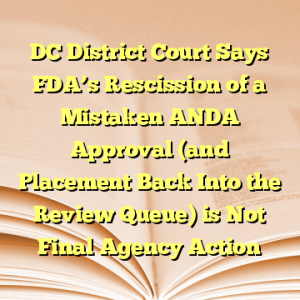
By Kurt R. Karst –
Earlier this week, the U.S. District Court for the District of Columbia issued a Memorandum Opinion granting summary judgment to FDA in a lawsuit Lannett Company Inc. and Lannett Holdings, Inc. (collectively “Lannett”) filed in June 2016 challenging FDA’s rescission of Lannett’s ANDA 202750 for the oral chemotherapy drug Temozolomide Capsules, 5 mg, 20 mg, 100 mg, 140 mg, 180 mg, and 250 mg. (Copies of the briefs filed in the case are available here, here, here, and here.)
As we previously reported, on May 17, 2016 FDA issued a letter to Lannett rescinding the approval of ANDA 202750 for Temozolomide Capsules, which the Agency had approved on March 23, 2016. According to FDA, the Agency approved the ANDA in error. ANDA 202750 identified Chinese company Chongqing Lummy Pharmaceutical Co. Ltd. (“Lummy”) as the manufacturer of the active pharmaceutical ingredient for the drug product. FDA inspected Lummy in mid-March 2016, and on April 19, 2016, the Agency placed Lummy on Import Alert, pointing to concerns over the company’s Current Good Manufacturing Practices (“CGMPs”) as the reason for the Import Alert. On June 21, 2016, FDA issued a Warning Letter to Lummy summarizing significant CGMP deviations.
Lannett alleged in a five-count Complaint that FDA’s rescission of ANDA 202750 violates the Administrative Procedure Act (“APA”) and the Fifth Amendment’s due process right to a hearing in connection with deprivation of a property right. Lannett asked the DC District Court to, among other things, set aside and declare as unlawful FDA’s ANDA approval rescission, and to enjoin FDA from revoking the approval of ANDA 202750 without a hearing and the procedures established at FDC Act § 505(e).
In a 17-page Opinion granting FDA’s Cross-Motion for Summary Judgment and denying Lannett’s Motion for Summary Judgment, Judge Reggie B. Walton concluded that FDA’s approval rescission of ANDA 202750 is not final agency action subject to APA judicial review, and that Lannett failed to exhaust available administrative remedies under 21 C.F.R. § 314.110(b) before filing its June 2016 Complaint.
FDA argued that Lannett’s lawsuit is essentially an attempt to bypass the administrative process, and that the doctrine of exhaustion of administrative remedies is a conclusive factor that should prevent the Court from consideration of Lannett’s claims at the present time. After all, argued FDA, the Agency “has not made a final, judicially reviewable decision on the manufacturing compliance status of the facilities named in Lannett’s ANDA,” because “[a]fter [the Agency] afforded Lannett due process and properly rescinded the ANDA approval, the application returned to pending status and was subject to regulatory requirements described in [FDA’s] Complete Response Letter.”
In response, Lannett argued that FDA’s ANDA approval rescission meets the test for a final agency action under the APA because it “was the consummation of the agency’s decision-making process to revoke the approval (not a tentative or interlocutory decision), and definitively adjudicated and revoked Lannett’s legal right to market Temozolomide capsules.” Lannett also asserted that the company “was not required to exhaust administrative remedies before filing this case” because FDA’s ANDA approval rescission “formally and definitively deprived [the company] of its legal entitlement to market Temozolomide capsules.”
After noting that “[a]An agency action is final if it ‘1) marks the consummation of the agency’s decision making process’ and 2) affects the ‘rights or obligations . . . [or the] legal consequences’ of the party seeking review,” and that whether “FDA’s rescission of a mistakenly approved ANDA and placement of that ANDA back into the review process queue is a final agency action” seems to be a case of first impression, Judge Walton proceeded with his analysis.
As to Lannett’s position that FDA’s action resulted in the “consummation of the agency’s decision-making process to revoke the approval” of ANDA 202750, Judge Walton said that that position “is too narrow for the Court to accept, primarily because Lannett’s position focuses solely on the rescission of the approval, which Lannett equates as a final agency action.”
Applying the principle that a court must look at the way in which an agency subsequently treats a challenged action when assessing whether a particular agency action qualifies as final for purposes of judicial review, Judge Walton concluded that “although the FDA did rescind Lannett’s ANDA approval, the FDA expressly advised Lannett that its ANDA was ‘now in pending status,’” among other things. As such, “FDA’s rescission action did not represent the conclusion of its decision-making process regarding the review process for Lannett’s ANDA or its ultimate decision to either approve or deny Lannett’s ANDA.”
And even if FDA’s ANDA approval rescission “could be perceived as the consummation of its decision-making process,” Judge Walton was not convinced that Lannett’s action satisfies the second prong of the finality doctrine above. Quoting from American Therapeutics v. Sullivan, 755 F. Supp. 1 (D.D.C. 1990) (here), a case that also involved FDA’s rescission of an ANDA approval because of CGMP concerns, Judge Walton wrote that Lannett “pictures itself, quite incorrectly, as having been deprived of a vested right. [Rather, i]t had no right to put on the market a drug when facts were available indicating that the public health might be injured.”
Moving on to the doctrine of exhaustion of administrative remedies, Judge Walton concluded that “FDA’s rescission action cannot be considered final because Lannett has yet to exhaust all of its available administrative remedies.” Citing FDA’s regulation at 21 C.F.R. § 314.110(b) concerning Complete Response Letter actions, Judge Walton said that “Lannett was obligated to comply with the procedures provided in the FDA’s regulations by either resubmitting or supplementing its ANDA, withdrawing its ANDA, or requesting an opportunity for a hearing.” But, instead of pursuing one of the specified actions, as the company should have done, “Lannett opted to file this action seeking judicial review.”
http://ift.tt/2i7Cqk9








